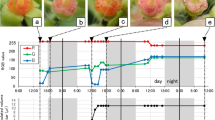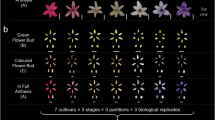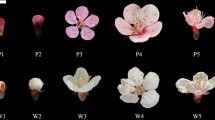Abstract
FROM earlier work it was concluded that the principal factor concerned in promoting blueness in anthocyanin-pigmented flowers of Lathyrus species was the presence of flavonol co-pigments1,2. It was of interest to extend the observations into the related genus Vicia to determine whether a similar conclusion might be reached. In the latter genus the range of flower colour is similar to that found in Lathyrus. Species were selected for investigation which gave some representation of the colour range. Hydrolysed extracts of standard and wing petals were prepared and then examined by filter paper chromatography as described earlier1.
This is a preview of subscription content, access via your institution
Access options
Subscribe to this journal
Receive 51 print issues and online access
$199.00 per year
only $3.90 per issue
Buy this article
- Purchase on SpringerLink
- Instant access to full article PDF
Prices may be subject to local taxes which are calculated during checkout
Similar content being viewed by others
References
Pecket, R. C., New Phytol., 59, 138 (1960).
Pecket, R. C., and Selim, A. R. A. A., Nature, 195, 620 (1962).
Pecket, R. C., J. Exp. Bot., 17, 177 (1966).
Author information
Authors and Affiliations
Rights and permissions
About this article
Cite this article
PECKET, R. Nature of the Variation in Flower Colour in Vicia. Nature 213, 1240–1241 (1967). https://doi.org/10.1038/2131240b0
Issue date:
DOI: https://doi.org/10.1038/2131240b0



